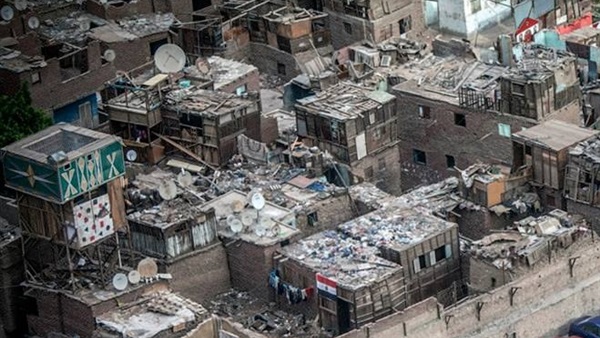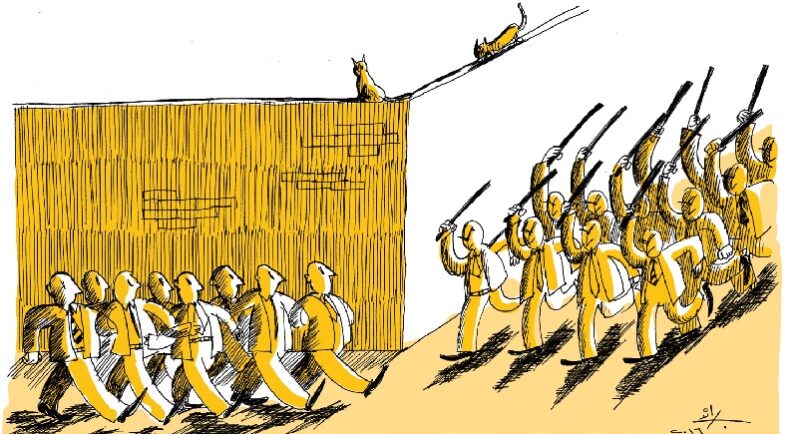Egyptian Court to Government: Rehabilitate Informal Areas

On December 24, 2016, Egypt’s High Administrative Court issued a ruling to put into effect a constitutional mandate set out in Article 78 of the 2017 Egyptian Constitution. In essence, it requires the state to put a comprehensive national plan into place in order to address informally settled areas. Before presenting the ruling and its supporting opinions, and the lessons that might be learned from it, we will present the context in which the ruling emerged. This high court’s ruling was a response to an appeal of another ruling from a lower administrative court, issued on February 15, 2005. This initial ruling was appealed by the minister of electricity, the governor of Cairo, and the president of the Helwan district, whom brought a case against one of the citizens in whose favor the original ruling had been made.
1- The Background of the Case
The following is a summary of the situation that prompted the initial administrative court ruling. On May 10, 2004, a resident of an informal settlement within the Helwan district of Cairo brought a case to court. He requested that the court stay a decision made by administrative authorities that disconnected the electricity to his home, located north of the power station in south Helwan. The electric authority had refused to allow electrical current to flow to the plaintiff’s residence because his building was in an informally settled area, for which no building permits had been issued. The plaintiff asserted that the decision to disconnect the electricity was unlawful, as the provision of electricity to informal areas does not depend on the existence of a building permit; and, emphasized that 150,000 people had been living in this area without electricity for a full year. He demanded that the electric authority’s decision be immediately reversed.
The administrative court issued its ruling (which would later be challenged) in favor of the plaintiff’s request, halting the implementation of the Helwan electric authority’s decision and its consequences. The court determined that the local administration had full knowledge of the plaintiff’s construction activities, which had taken place in the midst of a well-established residential community. The court also pointed out that it had suspended previous decisions by the administration to stop and then remove the offending building. It was this that had prompted the electrical authority to disconnect the flow of electricity without any justifiable reason, judging from the documents submitted to the court, making the decision prone to being struck down. The ruling was established on the basis not only of urgency, but gravity, given that the plaintiff resides in the building in question and a lack of electricity to the building constitutes an impediment to his residence, which has irreversible consequences.
The administrative authority appealed the administrative court’s ruling, taking the case to the High Administrative Court, where they complained that the ruling had violated the law and erred in its application and interpretation. The basis of their appeal was that the area where the original plaintiff had built his property, which he was demanding be connected to an electrical current, was in an informal area that had not been zoned. They argued that Article 17 of the Building Law (Law No. 106 of 1976, which remains in force today) states that utility authorities may not provide buildings, or units within them, with services until the building owner has been issued a certification from the relevant regulating authority indicating that the building in question has been granted a license for constructed buildings, and is in conformity with the relevant provisions and regulations.
2- The Ruling and Reasoning of the High Administrative Court
The High Administrative Court ruled to reject the appeal and uphold the previous ruling. It called for the reversal of the decision made by the Helwan electric authority to disconnect the electricity to the residence of the original plaintiff. The court justified its denial of the appeal on the argument that the previous administrative court had been in the right, and in accordance with the law for the following reasons.
- That the regulating authority has the right to refuse to issue a certification granting a licence, as described above, or to refrain from doing so; but that exercising this right is not a sufficient procedure for identifying violations in a building requesting access to utilities. Rather, such violations must be established in connection with the building’s owner by way of a judicial ruling that confirms the owner is in the wrong.
Moreover, once reports of violations are identified, the regulating authority must take action to stop building works that are committing violations, prevent their completion, and keep them from being populated with residents. Should the authority neglect to take these legally required measures to confront violations, to the point that these buildings are completed and filled with residents who then settle into their lives there, then there is no reason to prevent the provision of utilities to such a building; so long as it is standing and does not threaten the safety and security of its residents or anyone else. Thus, there is no basis for disconnecting the electricity.
-
The law prohibits constructing buildings except with a license from the relevant regulating authority, which is in turn granted the power to issue a decision to halt building works that violate regulations and bring the offending parties to criminal court. The governor, or his representative, is likewise authorized to remove or correct instances of violations.
By instituting these procedures, lawmakers intended to regulate the construction process so as to ensure the safety and security of citizens. and so that sound construction can contribute to Egypt’s housing resources. But if a local authority has ignored these procedures or neglected to follow them, and there is no way for the situation to be reverted or corrected to the way it was before, then there is no justification for preventing residents from accessing public utilities.
-
The provisions of Article 17 of the Building Law state that for a building to receive public utilities, it must be granted a certification from the relevant authority indicating that the building has been licensed. But this does not apply in the case of informal settlements that are on unzoned lands and were built without licenses, because no license existed in the first place.
Requiring that such a certification be issued would make it materially and practically impossible to provide these buildings with public utilities. Yet, such services are considered vital necessities for the people living in these buildings. Furthermore, these buildings were constructed in full view and within earshot of the administrative authorities, and are now integrated residential neighborhoods. In other words, they have become a reality that the state cannot ignore. Rather, the state must work towards developing and regulating these areas in order to protect the well-intentioned individuals who aspire to adequate housing, where a person might find tranquility and maintain his humanity.
-
Given the practicalities of the situation, authorities must address the phenomenon of informal areas. In light of the housing crisis, these residential communities can give rise to negative and deteriorating environments that are among the most serious problems their residents face. The authorities must address these issues rather than resort to legal ruses that might help them, but at the expense of citizens’ livelihoods. These areas deserve the state’s attention. The court is awakening the government’s ambition regarding a 2008 presidential decree that established an Informal Settlements Development Fund. Its aim was to limit and develop informally settled areas, to establish an urban planning strategy, and to provide these areas with basic services including water, sewage, and electricity; all with the goal of stopping the phenomenon in its infancy.
3- Lessons to be Learned from the Ruling
This ruling, along with others issued by the administrative courts, affirms what we have stated previously about the social and humanitarian role of the administrative judiciary.[1] The significance of this ruling is evident, given the considerable number of informal areas that are dangerous and unsafe, and are in urgent need of development. There are now 351 such areas, most of them in the Greater Cairo region. According to surveys conducted by the Central Agency for Public Mobilization and Statistics, they are home to nearly a million people.
The High Administrative Court’s ruling is prompting state authorities to fulfill the obligation imposed by Article 78 of the 2014 Constitution. This article states, “the State shall ensure the citizens' right to adequate, safe and healthy housing in a manner which preserves human dignity and achieves social justice…The State shall also devise a comprehensive national plan to address the problem of unplanned “slums”, which includes re-planning, provision of infrastructure and utilities, and improvement of the quality of life and public health. In addition, the State shall guarantee the provision of resources necessary for implementing the plan within a specified period of time”. Article 46 of the Constitution reaffirms that this is a human right, specifying that “every person has the right to a sound [and] healthy environment”.
Thus, the government has a constitutional obligation to implement a comprehensive governmental plan to develop informally settled areas. After letting these area develop, spread, and deteriorate, the government should not then deprive these areas of services that are essential for living. These negative environments not only put their residents at risk; they also expose society as a whole to danger, when informal areas end up fostering abnormal behavior patterns and become focal points for illegal activity.
Some might take the view that the ruling, which requires authorities to provide necessary and vital services to informal areas that are neither zoned nor planned, might encourage illegal building. It is true that illegal building has produced dire consequences for both the provision of basic services, and for the safety and security of individuals. Examples have appeared in Alexandria and other Egyptian cities and villages recently, whether in the form of illegal construction in the cities, carried out without a license or in violation of regulations, or in villages, where construction is eating away at already scarce plots of agricultural land. But the ruling took this into account by indicating that regulating authorities have both a right and an obligation to, “take the initiative to stop these transgressions from the start” as explained above. Thus, the ruling directed administrative authorities as to their responsibilities: They should prevent building violations early on, stop those that are ongoing, and prevent those committing violations from benefiting from them.
It is only fair to note our appreciation for the personal commitment of Egypt’s president to evacuate all informal areas that are “dangerous and unsafe”, and to provide their residents with new housing units within three years. Likewise, we appreciate his requiring the government to work to prevent new informal settlements from emerging. Indeed, the state has recently begun developing 45 informal areas within the governorates of Cairo, Giza, and Helwan. This work has been done according to a protocol for cooperation between the fund for the Informal Settlements Development Fund, the Federation of Egyptian Banks, and civil society. The state’s construction of Asmarat Districts 1 and 2 in the Katamiya area, will enter its third phase by the end of 2017, so that residents of the al-Duwaiqa and Mansheyat Nasser informal areas can move. Within the same framework is the Beshayer al-Khair[1] project in the Ghait El Enab area of Alexandria, which encompasses an integrated residential area. It has been planned, executed, and financed through coordination between the armed forces, the governorate of Alexandria, and civil society organizations; and, without placing a financial burden on the state’s budget.
The High Administrative Court’s ruling clearly sought to strike a balance between the following two factors. The first is the need to regulate construction procedures for the sake of citizens’ safety and security, so that sound construction can contribute to Egypt’s housing resources. The second is the individual’s right to have access to public utilities that are deemed vital and as being indispensable necessities.
This ruling along with others from the administrative judiciary indicate the ways that innovation and creativity are considered sources of administrative law. Since its establishment, the administrative judiciary has worked to establish and enshrine values and principles that are indispensable to individuals’ lives and to the advancement of society; whether they be political, economic, social, or cultural values. Such values and principles are rooted in the Constitution, or derived from general legal principles and the rules of justice.
This is why we consider this ruling to apply beyond the particulars of a case in which authorities limit citizens’ ability to benefit from key public services. The ruling might be transferred from the specifics of the situation to the general principle that guides it; an explicitly stated constitutional principle compelling the state to develop informal areas to prevent the formation of negative, deteriorating environments. We have no doubt that the first step in this development must be to provide these areas with the essential utilities that are indispensable to living a dignified life, while they await more comprehensive forms of development.
This article is an edited translation from Arabic.
__________
[1] See: “Judicial Ruling Bans Removal of Martyr Memorials from Egyptian Squares”, The Legal Agenda, June 5, 2017.



